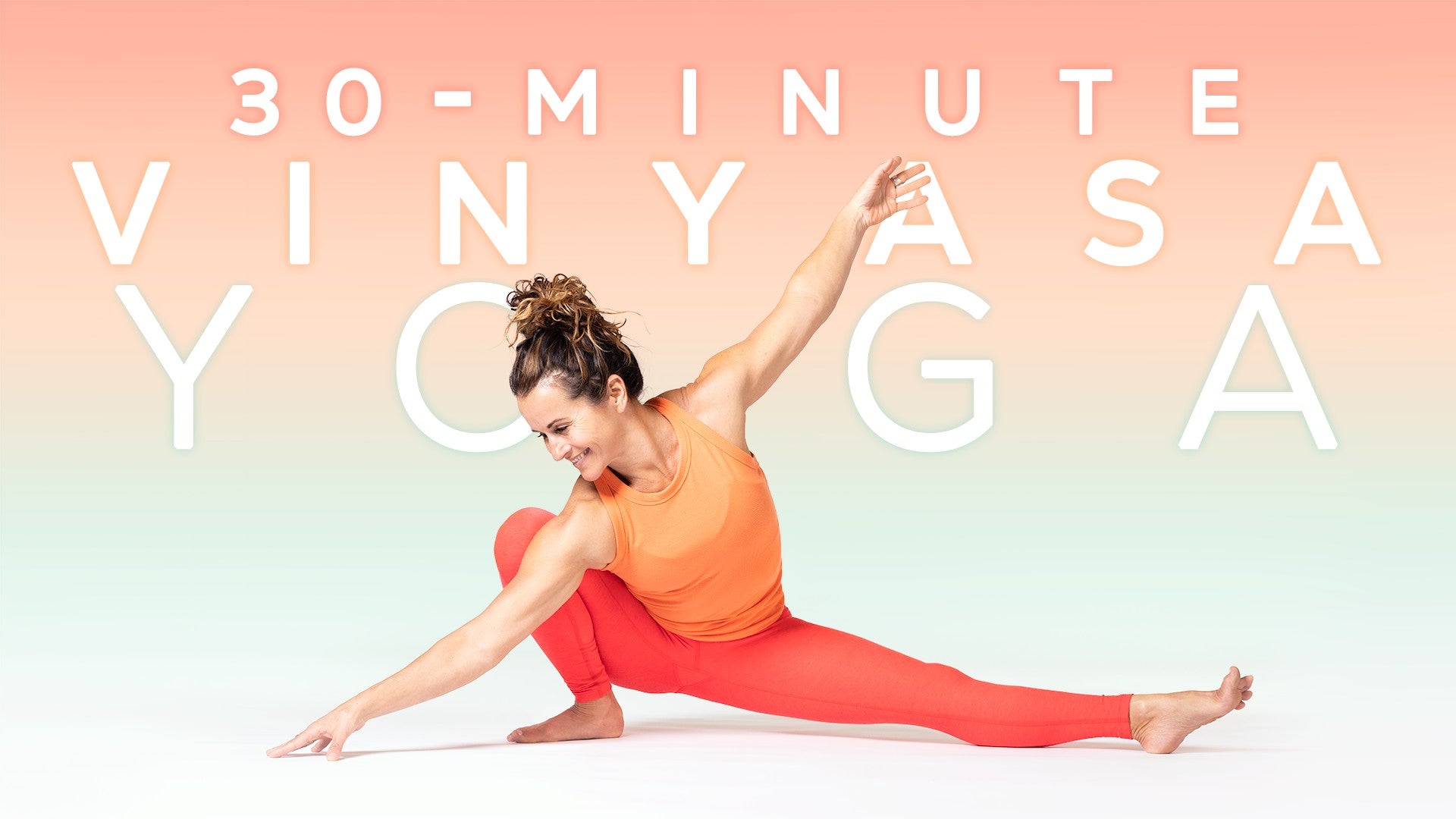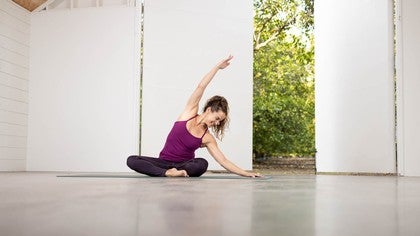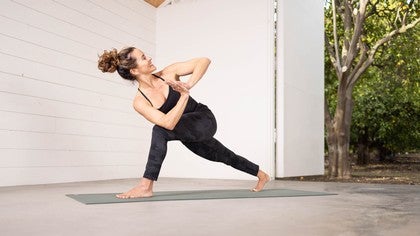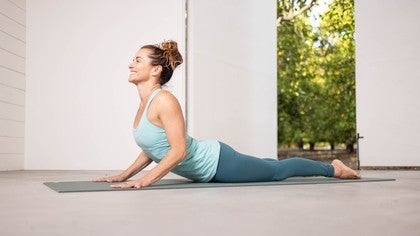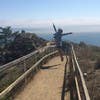Description
About This Video
Transcript
Read Full Transcript
Greetings, friends. Welcome to your ether element or space element practice. It'll be helpful to have a bolster and a strap for this practice and also a wall space near you. Let's get started. As you inhale, just circle the arms out and up around your body, reaching up towards the sky, towards space.
And as you exhale, draw the hands down the midline, back through the central channel. We'll do this several times with the breath. And as we move and breathe to open up our practice, we're really just creating this sense of a container around ourselves. And it's an invisible container, right? And it's always there, this space around us as we inhale and expand and exhale to draw back to the midline.
We look at these different systems of the elements and of our energies. We name them like earth, air, fire, water. And it's important to remember that within each of these systems, we have something containing and holding them all. And so as we connect into that great invisible, intangible container, it allows us to just experience our practice in a different way. So we'll be moving in less vinyasa patterns and more just kind of holding each shape and really feeling the medicine and magic of each posture.
So let's enjoy about four more breaths here. Very simple. As you inhale, circulate out and up. And as you exhale, using this simplicity to center yourself, we'll add the sound of om on our next exhale. So full breath in.
Pause at the top. Let's do that twice more. And it's important to remember that sound connects us to the universe around us. Once more, full breath in. Release your hands to your knees, lift your chest.
Let's start to circle our rib cage over the bowl of the pelvis, coming into some Sufi rolls here. And again, as you move and breathe, really take your awareness down into the space between the ribs and the pelvis, creating movement, allowing a little energy flow. Totally fine to let your hips kind of weeble wobble off of the mat here. And then changing directions and massaging into the low back and the kidneys, all the digestive organs, the space in between the ribs. And just taking your awareness to that kind of concept of space, where we can create space in our joints, maybe even create space between the thoughts, between the breaths.
Take one more circulation here. And then come back up to the center. Sit tall for a moment. Close your eyes. Feel yourself aligned from the earth beneath your seat to the sky above your crown.
Deep inhale here, just really rooting through your sit bones to rise up through the spine, through the heart. As you exhale, relax the shoulders. Once again, open up your eyes. Take one arm up and over, creating a nice big side bend here. You can press into your opposite palm to root opposite hip down.
Turn your heart open towards the sky. Imagine the space between the stars. And then as you exhale, circulate forward and down, clearing the space in front of you. Coming up into a twist, opposite hand comes across to your opposite knee. Sit tall.
And then exhale, turn your spine, looking over the rear shoulder. Just take a moment or two here and feel into this shape. So simple and so healing, seated twist. Coming back to the center, let's take the second side, so scooping out up and over into your side bend, grounding down through the opposite hand to root the opposite hip. And then turn your heart, visualizing stars in the sky or clouds, sunshine, and the space between.
Exhale, circulate forward and down, sweeping out in front of you. Coming up into seated twist to the opposite side. Sit tall. And then exhale, turn your spine, and slowly release. Let's take our bolster up to the top of the mat and our strap.
We'll be using this for our next couple of postures. And tuck and roll onto your side. We'll come into a posture that we worked with earlier in this particular season, cat catching its tail. So bringing the top knee forward, slide the hips open towards the earth, and then reach back, grab onto the big, little toe side of the back foot if you can grab it. Drop down into gravity.
And the more that you can turn the center of your back thigh down and kind of away from the midline, the more you're gonna be able to feel this opening through the front of the quadriceps and the hip flexor, creating a little spaciousness there as you breathe into it. And just rest in this posture. What would it feel like if we stayed here for five minutes? We won't be here that long, but give yourself permission to drop in in that way. Like, okay, I'm gonna get comfortable and enjoy this.
Notice how you feel. Notice your energy today. And if you're feeling, you know, the need for a lot of movement, if this feels too grounding and too restorative, just notice that, allow a little space for it, right? See if you can stay with this practice, see what it gives you. It can be challenging for many of us to sit still, to hold still.
But I'd love to just invite you to get curious, to explore what happens when you stay with something for a little bit longer than normal. We're gonna shape shift this particular posture into a side lying royal dancer. So it's another quadricep opener with a bit more of a back bend. And we'll use the strap for this. So you can let go of the bottom foot and just come back up onto a seat for a moment.
And I like to take a little loop here at the bottom of the strap and place it around the sole of the foot. Just gives you a little bit of dexterity here when we go into this one. So come back onto your side and then take your top leg behind you. Strap goes over the shoulder. The bottom leg is gonna kick forward as your counterbalance.
Now you're welcome to rest here with one arm behind your head as you press the thigh back. Or if you prefer, you can just push your bolster out of the way and take both arms behind your head and rest on your upper arm. I kind of prefer this option. And this is a really nice way to explore this posture because normally we're doing this standing on one foot and kind of navigating most of our attention towards the balance point. So when we turn it on its side, it has a completely different feel to it and different quality.
And we can hang out here for a lot longer than we would if we were standing. So let's enjoy this shape. Expanding the back foot, pressing it away from the midline, drawing the tailbone down a bit, just breathe with it. Notice if that top knee is lifting up and invite it to become parallel to the earth. And then as you exhale, just slowly bring your leg forward once again, you can reset your bolster and stretch your leg out in front of you.
So we have a Padagusthasana but we're on our side. Let's open it up into a twist. We have the opportunity to do this at the wall standing so you can just feel the difference. From here, we'll slowly release. You can take the strap off of your foot, we'll save it for the second side.
And then tuck and roll onto your opposite side. Coming into cat catching its tail, top knee goes forward, bottom leg goes long. I like to wiggle the bottom leg back and turn it so that the center of my thigh is facing the earth. And then reach your free hand back behind you to grab onto the foot. Gently draw it in.
Listen to the sound of your breath here, three or four nice deep steady breaths. Giving yourself a little time. Giving yourself a little sacred pause to feel and notice and witness what's happening right here in this moment or in your life in general. Where are you at right now? How are you doing?
We get going so fast from moment to moment that we sometimes forget to check in and just kind of pull back to the wide angle and see the big picture of things. So take time, take some space to do that. We'll let this turn into a side lying royal dancer. So once again, you can press yourself up and take your strap to your foot, going into the opposite foot this time. And then just tuck and roll, come on back down onto your side.
Top leg is going to go back behind you into a side lying royal dancer. Bottom leg reaches forward, option for just the top arm to hold the strap or to press the bolster out of the way and both arms reach behind your head and your upper arm can provide a little pillow for the side of your head. Checking in with the degree of top knee opening up and bring it parallel to the earth and just explore here. Check it out if you press your foot back and create a little more distance between your top foot and your glute versus if it's close, how that feels. Reaching the heart in opposition away from the bottom leg.
One more breath here. And then let's slowly draw the top leg forward, stretch it long in front of you, holding onto the strap with your opposite hand and then opening up into a twist. Slowly releasing out of this shape as you're ready, you can take the strap off, set it to one side, climb on up to hands and knees. So let's go ahead and prepare ourselves to come up through downward dog to the wall. We'll take those same couple of postures with the strap out the wall and just really feel the difference as we lift the hips up and back into down dog and arrive here fully.
We create a little more distance between the feet, which creates a little more space in the low back and hamstrings, putting a soft bend in the knees and press back from hands to hips. And just really try to create some traction here between each and every vertebra. Breathing into the spaces between, visualizing your breath moving throughout every cell in the body, swirling around you. That big invisible, intangible container around us all, breathing through and into that. Let's start to walk our feet towards the center of the mat, our hands towards the center of the mat.
Soften the knees, relax your head and neck, roll up your spine and you can bring your strap with you as you roll up, coming into tadasana, mountain pose. Standing tall here, arriving. This is often a posture that we kind of pass through quickly. So just take a moment, ground down through the feet, feel your energy rebound up through the legs, through the heart as the shoulder rolls back and down, tailbone slightly dials down as the low belly lifts, lengthen through the neck, through your crown. Let the palms be open, gaze soft.
And last but not least, it always can't hurt and oftentimes helps to just add a smile to your posture. So let's take a transition here over to any wall space that you might have. A countertop and a chair works as well, but a wall space is the best and bring your strap with you. We'll take those last two postures that we just experienced side lying on our mat and just take them up to standing. So loop the left foot and take your left arm behind you as you pull the heel towards your buttock.
Right fingertips can be on the wall. We start to build our royal dancer from here and there's really so many degrees. You can keep the strap over your shoulder, a little more lunar and subtle, or you can expand and reach it back and start to walk your hands down the strap, pressing your foot into the strap, creating a nice big arch through the spine, creating space at the shoulders. Breathing here for just a moment, notice the different relationship to gravity creates a whole different effect on the body. And then let's go ahead and take that foot forward.
I'm going to just slightly adjust and step back a bit so that I have a leg length from the wall. You can let your strap release. One hand to the outside of the ankle or shin and then sweep the opposite arm back, turning your palm to face up and turning your gaze with your palm. Taking a few breaths here, allow the outer left hip, if you have your left leg up, to drop down and continue to breathe. Slowly release.
Reach your arms up and then take your hands back to the wall. We'll set the strap to one side, option here to either come into push wall, it's just like a downward dog at the wall, or you can take the same shape and turn it upside down. Take a little pivot and line your hands up with your feet and just walk the feet about three feet up the wall for L pose. And I love to take one leg up into the space above me, finding our handstand here with support, maybe taking the second side, noticing how you feel, very powerful pose. And then as you're ready, you come out of that push wall or handstand.
Take your strap and let's enjoy the second side. So we start with royal dancer, looping the opposite foot, finding your arms distance from the wall and taking your strap over your shoulder. Lift up to whatever degree, if you want to come into the same variation that you did on side one or a different one, just noticing how your body responds, noticing quality of mind. We've kind of removed a lot of our complex transitions out of this practice, just moving from one shape to the next really purposefully and in an unornamented way so that we can just absorb all the juice. Let's transition this to bring our foot to the wall and adjust my stance.
Allow the strap to dangle down one hand to the outer shin and then turn into your twist palm open, turning your gaze, the outer right hip dropping down. One more breath. Slowly release, option to take push wall or that inverted L pose, handstand. I'm going to take push wall this time, creating some space at the heart, under the shoulders, breathing here and let's go ahead and slowly release. We'll head on back to our mat with our strap and we'll be coming back down to the ground here.
So as you're ready, you can come down any way you like. I'm going to take a half sun salutation to come back down. So we'll circle the arms out and up, full body breath, exhale, forward fold. Inhale to lift the heart and then we come right back where we were in downward dog. Only feeling quite different.
So let's prepare to come into either pigeon or a threaded needle. You can take the right leg to the sky, sweeping it up nice and slow, really feeling the openness through the back channels, the lines of energy in the back of the legs. And then as you exhale, draw the knee forward, hover in your plank, just feeling each shape that we kind of speed through sometimes. Turn your shin out and then bring your right knee up right behind right wrist. We'll slide back.
Since we have our bolster here, let's turn it and enjoy, oh, coming on down. And you can rest one cheek or the other or your forehead on the bolster as you like. If you have any compromise, any kind of sharp shooting pain or anything in your knee in any pose for that matter, you can modify it. So a threaded needle would be the option for this one to come onto your back. Relaxing here, five deep breaths.
Last breath here. As you exhale, slide your hands right to the edges of the mat, lift your heart up, coming into upright pigeon, fingertips rooting and grounding as you lift up through the heart. And maybe before we exit, try pressing into the top of the back foot and lifting the knee, creating a little space underneath the pelvis, feeling that upward rising energy through the spine. Just activating this shape for a moment and then exhale it, sink down. Curl the back toes under, we'll press back to downward dog.
Take the same right leg to the sky and then slowly release it down, replacing it. Left leg rises on an inhale, take the entire length of your inhale to lift your leg, rising up onto the toe, exhale, knee comes forward, hovering in plank, feeling each shape, enjoying each shape, turning it out, setting your knee down just behind the wrist. Slide back through the hips and then forward and down into pigeon. Forehead can rest on the bolster, you can turn your other cheek and rest it on the bolster. Five deep breaths.
Take a slow scan of your body, notice where you might be holding tension. Sometimes it gathers in sneaky places like in your fingers or toes, in your jaw, your neck, even your scalp. And simply by bringing your awareness to it, we can soften and relax. One more breath here and slowly start to slide your hands to the outer edges of the mat, coming up onto the fingertips as you lift your chest and rise up into upright pigeon, lifting up through the heart, perhaps pressing into the top of the back foot and lifting the back knee. Maybe lift your palms, see how that feels, to activate it for a moment.
And then exhale, slowly come on back into downward dog, we'll take that same left leg to the sky, just to open up the back of the knee, and then exhale, set it down like you're setting down the day. Bend your knees, shift down and over to one hip, and we're about to come back down onto our back. We'll use the bolster underneath our pelvis once we lie down on our back. So just have it handy at one side of the mat. So let's bring our legs straight out in front of us, maybe scoot forward a bit so you have a runway behind you.
Again, just this whole practice, we're looking to find space and create space everywhere we can. It's a nice practice to embrace for life off the mat as well. Start to roll down, slow and steady. And once you arrive onto your back, just float the knees into the chest. Reach your arms and legs up into the space above you.
Take a couple circulations of ankles, wrists, fingers, toes, go the opposite way. And then bring your feet down. Let's lift the hips up and slide your bolster right underneath your pelvis. You want to make sure it's under the sacrum. If it's a little high at the low back, it puts our pelvis into an anterior tilt, which kind of doesn't feel great on the low back.
So we want it to be a bit lower so the back of the waist can kind of melt into gravity. Right knee comes to chest, left leg reaches long, and this gives our psoas hip flexors a chance to just drape into gravity as we draw the right knee in. This is a fantastic posture to work with for all of us, but particularly if you have a cranky lower back. This helps to release it. Let's enjoy a few deep, slow breaths here.
Open your right leg up to the sky, opening up the back of the hamstring, maybe pull your right leg towards you, and that left leg can naturally float. Scissor and switch your legs through space a few times here. The next time your left leg is in, keep it there, bend your knee, and let the right leg drape down. Four breaths here. Scanning your body for any remaining pockets of tension or holding.
Scanning your mind for any remaining pockets of tension or holding. Let go on the exhale, decluttering from the inside out. Last breath here. Let's extend the left leg long, and then just float it down, bending both knees so the feet are flat on the mat. Lift your hips just enough to slide the bolster down towards your heels, wiggle it down so that when we set up for our shavasana, the bolster is supporting the back of the knees, which again is really nice for your lumbar spine.
Head out. Relax your arms wide, palms open towards the sky. Feel yourself connected. We literally are stardust. We have all the elements present within our body.
All the elements that we see around us are inside of us. So as you drop into this shavasana, perhaps visualize your favorite constellation or star in the sky, connecting to the space around it. We typically call the negative space, and it's not negative at all. It's completely open for potential. You're welcome to stay here as long as you like, resting in your shavasana.
If you'd like to close your practice formally with me, just send a little movement to your fingers and your toes. As you stretch your arms over your head, reach your legs long. Feel that internal shimmer. Exhale to hug your knees in to your chest. Rock off to one side.
Come on up to a comfortable seated position, perhaps adjusting your bolster so you can have a seat on top, and then coming back to that very simple opening movement that we did at the beginning of our practice, retracing this beautiful container around us, the great container space around us. We inhale and exhale. Hands come down the midline, slow and steady past the third eye, throat, heart, navel, hips, and just turn the palms open, remembering anything is possible, especially when we create the space for it. Hope you have a beautiful day. Thank you so much for sharing your practice and your energy with me.
Namaste.
30-Minute Vinyasa Yoga: Shelley Williams
Comments
You need to be a subscriber to post a comment.
Please Log In or Create an Account to start your free trial.
